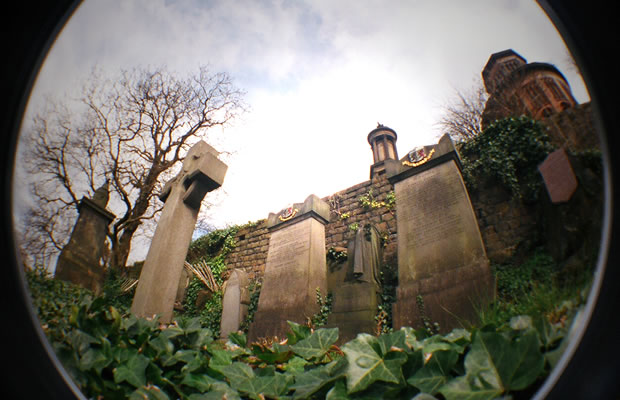
The Necropolis
Most cities have graveyards, but very few can boast of a city of the dead, or what is the same, a necropolis. An even more lurid detail is that Glasgow has two: the Necropolis and the Southern Necropolis, but, today, we will concentrate on the classic one.
Built towards the centre-east of the city, the Glasgow Necropolis is a Victorian cemetery, that is, a cemetery from the nineteenth century, in all its Gothic splendour. It is built on the grounds of an old park of firs and accommodates 50,000 resting places, mainly reserved to wealthy families. Here, however, are also many people buried without a tombstone, and tombs date from 1832 until the 1960s (with some exceptions).
The view from the John Knox‘s monument, the highest point, provides an exemplary overview of the city. You can see on one side, the cathedral and the Royal Infirmary, on the other, the Tennent Caledonian Breweries, which fills the air with a pleasant yeasty smell. And then there, right in front of you, Calton, Glasgow’s neighborhood with the lowest life expectancy in Europe (an average of 54 years for male residents). Very little mental power is needed to figure out a way to relate of all of these factors -alcohol, hospitals, churches and cemeteries.
But let’s not be too gloomy. We have a path to follow in our visit. A complete tour of the crypts, mausoleums, ancient Egyptian catacombs and cenotaphs, starting with the Bridge of Sighs, takes about two hours and can be organized through the association Friends of Glasgow Necropolis. It is advisable to get tickets well in advance, given the popularity of the tour. If the timetable is not convenient to you or if you travel with a group, you may also be able to arrange an individual tour through that same association, although I recommend buying a guide at Waterstones (Argyle Street – Scottish Section), and just do a derive. Only thus you will be able to enter into the spirit of the place. But despite the fog that may come to meet your expedition, this is not only a literary, historical, social or anthropological visit. Many of the 3,500 tombs of Glaswegian merchants were designed by the star architects of that era, such as John Thomas Roche, Alexander ‘Greek’ Thomson and Charles Rennie Mackintosh, the main representative of Art Nouveau, a precursor style of the revered Deco.
The Necropolis is open most days from 7 am until dusk, which, in winter, is about three o’clock in the afternoon. But don’t fear, if the sinister sights and sounds startle you and you lose track of time, the main doors, which are in Castle Street behind St Mungo’s Museum of Religious Life and Art, can be climbed up relatively easily. And do be careful during your visit, because accessibility is one of the limitations of the Necropolis. Any visitor should be fairly fit. The state of the tombs and general architecture (stairs, entrances, etc.) are a historical site, that is, they have not been touched almost since they were built. And if we add to this the quality of the earth, softened by constant rain, and the fact that this cemetery is on a hill, as you can imagine what you will encounter.
But do not let this dissuade you. This place is magical, mysterious and utterly charming, worthy of a story by Edgar Allan Poe. I am still surprised that there are no world-famous noir writers in the city, creators of detectives solving cases in this the old ‘Second City of the Empire’, because the Necropolis has nothing to envy Edinburgh’s vertical environment, where most of Ian Rankin‘s books take place. People I know, though, have come across television crews filming episodes of Taggart, a police drama set in the ’80s, which lasted 24 seasons, and whose protagonist has returned from the dead a few times (how appropriate!).
The Necropolis can be a sinister place, with bats and wind, and silent graves; but also playful and creative (often, in my visits, I find children playing games, or see avid readers). It is also testimony to the history of the city. And while these different aspects can be contradictory sometimes, here, they live together.





Just to say that the Friends of the Glasgow Necropolis appreciate the recommendation. Two corrections are that Glasgow has 4 Necropoleis – Glasgow, Southern, Eastern and Western Necropolis.
There is a typo around JT Rochead. Just says Roche.
There have also been full interments since 1960 – only if you already have a family lair. Also a lot of families still bring ashes to be buried in the family lair.
Regards
Ruth Johnston Chair of the Friends of Glasgow Necropolis